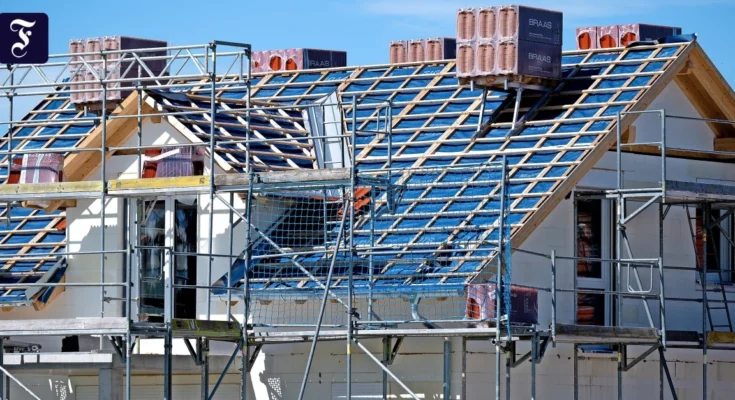The dream of having your own house or apartment is common in Germany. If you ask young people what they want for their future, having their own home is often a top priority. This should be a home where you don’t depend on the owner’s help, they say. It is best to have a park where children can play. However, if you ask how the financial situation is with this dream, many people become disappointed. Real estate prices are high, especially in urban areas. Building interest rates were even lower a few years ago.
It cannot be denied that buying property is not an easy thing. If you don’t want to give up on your desires, you need a well-thought-out savings plan.
First, you need sufficient equity
The money needed to buy a house usually comes from two sources, your own money and a bank loan. The first big challenge is saving enough equity. The rule of thumb is that buyers should finance about 20 to 25 percent of the property price out of their own pocket. Smaller equity is also possible, but larger loans will have to be taken. This risks the monthly loan installments being too high or the repayment period being too long. In addition, property buyers must also pay an additional purchase fee of ten percent themselves, which is intended for property transfer or notary taxes.
Financial consultants VZ Vermögenszentrum have calculated for FAS how high the monthly savings rate should be to save enough equity in twelve years. That’s a long time. “But especially those starting from scratch must have sufficient stamina,” said Michael Huber, head of Germany’s VZ Vermögenszentrum. The German average price for a single-family house with an area of 140 square meters is currently around 478,000 euros. For an equity share of 25 percent plus additional purchase costs, around 168,000 euros would be required – likely to be less, as real estate prices are likely to continue to rise in the future. However, because these developments are difficult to estimate, current prices are used for evaluation.
Anyone who keeps money in an interest-free account should set aside around 1,200 euros a month for twelve years. However, many young professionals are unable to manage such high savings rates. According to figures from the Bundesbank, the annual household income in the twenty-five to thirty-four age group is around 32,500 euros net, i.e. 2,700 euros per month. The median is measured, so half earn more and half earn less. Therefore, in his calculations, Huber assumes that savings levels are invested in fixed term deposits and shares to achieve an annual return of 3.5 percent after tax with this mix. How exactly will be explained later.
Of course, young homebuyers with families who can also contribute some money will have it most easy. For example, if parents add 75,000 euros as an initial inheritance, potential homebuyers will need to set aside around 520 euros a month to reach their goal. Anyone who has to live without family support must save 940 euros a month (see graph). Divided by two, the cost is 470 euros per month.
Invest in stocks for the first few years
Finding a good mix of term deposits and shares is important. Huber experts suggest the following strategy: In the first six years, the money is invested in ETFs that mimic global stock markets. This allows you to make solid profits – but shares are associated with a certain amount of risk due to their price fluctuations. Therefore, over the next six years, the entire monthly savings rate will go into daily and fixed term deposit accounts. The interest is less there, but the money is still safe.
Additionally, from the eighth year onwards, investors should gradually shift their equity assets to term and fixed term deposit accounts, Huber suggests. That’s 20 percent of the total shares per year, assuming a total term of twelve years. Although Huber recommends: “Savers should maintain a little flexibility depending on the stock market situation,” he said. Savers should be aware that no one knows for certain what interest rates on term deposits will be in any given year. At this time, there could also be a severe crisis in the stock market. In the worst case, it can take several years for prices to recover. So just wait; savers should delay purchasing their own property. If you can’t handle it and want to commit to buying a house in a certain year now, you should invest more money in safe interest-bearing investments such as fixed term deposits or bonds from the start. But the savings rate should be higher.
For many people, this monthly amount is a lot of money, even if you divide it by two. Buying a house can be done a little cheaper, for example by choosing a smaller property. Or move to a rural area where property prices are lower. Calculations from VZ Vermögenszentrum show: If a house costs only 370,000 euros, a household would have to set aside around 730 euros per month to reach the savings target – 200 euros less than the average across Germany. If parents add something else, the price is 310 euros.
At the same time, these numbers also raise the question: How affordable is real estate for young families? And most importantly: Did your parents ever have it easier?
Real estate prices are high, and so is demand
There is no clear answer to this, especially since the generations are spread over decades and much has changed over time. Model calculations carried out by analysis company Empirica on behalf of Landesbausparkassen LBS conclude that, currently, almost six percent of renter households aged between 30 and 44 have sufficient assets to purchase property in their area, based on regional prices. Some of them might save enough later, but of course not all of them. 15 years ago the proportion was almost ten percent.
Reiner Braun, Managing Director of Empirica, looks at several reasons why buying a home is so difficult for many people. There are clearly visible impacts, such as sharp increases in real estate prices. Structural requirements for homes are also increasing. “In the past, for example, working on construction sites with relatives or friends was commonplace.” Nowadays this rarely happens, because many people do not have the necessary knowledge. This also makes buying a house expensive. At least the development interest rate is lower than, for example, in the early 1980s, when it was nine percent. This makes loan repayment easier.
Braun also sees some of the responsibility lying in the hands of the younger generation themselves. He noticed social changes that people in their twenties wanted to leave behind. “Going to restaurants or going on holiday regularly is now part of recreational activities – like never before,” he said. This is a fun experience, but there is also less money to be saved. Young couples are now more often drawn to cities, as there are more jobs and culture, but houses and apartments are very expensive – so many more have to save.
If you manage to build up enough equity, you can take the next step: a construction loan. Overall, monthly loan payments should make up a maximum of 30 to 35 percent of your monthly budget, that’s the rule of thumb. Empirica model calculations show that things are easier for young households: about 40 percent have the necessary income. Income hurdles, as experts call them, are less difficult to overcome than equity hurdles.
Monthly loan installments 1450 euros
When making such calculations, keep in mind that income often fluctuates, especially between the ages of 30 and 40. If parents reduce working hours to care for children, this will be reflected in the monthly budget. However, this can also be offset by salary increases through promotions. The average interest rate for a ten-year fixed rate is currently 3.6 percent, according to construction finance company Interhyp. It is difficult to make forecasts for the coming years. If you take the initial example of a property priced at 480,000 euros and finance 75 percent of the purchase price with a loan, you get a monthly payment of 1,450 euros at the current interest rate. The payout is two percent. At the end of the fixed interest rate after ten years, approximately 75,000 euros will be repaid, and a new loan will have to be taken out for the remaining amount.
This also shows that a property not only requires the discipline of saving before buying it, but also for years afterward. Not everyone can and wants to get involved in it. But if you want to make your dreams come true, you have to be ready with this plan.



